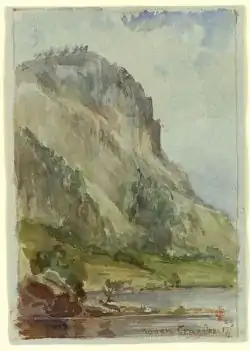Edward Clarke Cabot
Edward Clarke Cabot (August 17, 1818 – January 5, 1901) was an American architect and artist.
Edward Clarke Cabot | |
|---|---|
| Born | August 17, 1818 |
| Died | January 5, 1901 (age 82) |
| Occupation | Architect, artist |
| Spouse(s) | Martha Eunice Robinson (m. 1842) Louisa Winslow Sewall (m. 1873) |
| Parent(s) | Samuel Cabot Jr. Eliza Perkins Cabot |
Early life

Cabot's father was Samuel Cabot Jr., a shipping businessman. His mother was Eliza Perkins Cabot. He had six siblings: Thomas Handasyd Cabot (b. 1814), Samuel Cabot III (b. 1815), James Elliot Cabot (b. 1821), Stephen Cabot (b. 1826), Walter Channing Cabot (b. 1829), and Louis Cabot (b. 1837).
Career
Cabot designed the Gibson House for widow Catherine Hammond Gibson and her son Charles Hammond Gibson Jr, as well as the new building for the Boston Athenaeum between 1847 and 1849. After the opening of the Boston Athenaeum, he became a leading figure in Boston architectural circles. The Athenaeum was influenced by Charles Barry's Italianate club house in London. He is also noted for producing several distinguished Queen Anne Style houses in the 1870s.
Cabot later formed a firm "Cabot and Chandler" which built numerous residences in the Back Bay and Boston environs. In 1879, Cabot & Chandler responded to H.H. Richardson's introduction of the Stick Style of Architecture into the U.S. by his Sherman Watts House in Newport, with Cabot's splendid mansion for Elbridge Torrey at 1 Melville Avenue in Dorchester, MA. The same year the firm designed 12 Fairfield Street in Boston's Back Bay for Georgiani Lowell.
Personal life
In 1842, Cabot married Martha Eunice Robinson. In 1873, he married Louisa Winslow Sewall. He was the father of football player Norman Winslow Cabot.[1]
References
- Harvard College Class of 1898 Quindecennial Report. Harvard University. 1913. p. 51. Retrieved 22 June 2018.
- Curl, James Stevens (2006). A Dictionary of Architecture and Landscape Architecture (Paperback) (Second ed.). Oxford University Press. p. 880. ISBN 0-19-860678-8.
| Wikimedia Commons has media related to Edward Clarke Cabot. |